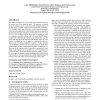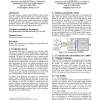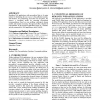WWW
2004
ACM
15 years 29 days ago
2004
ACM
We present a Semantic Web application that we call CS AKTive Space1 . The application exploits a wide range of semantically heterogeneous and distributed content relating to Compu...
WWW
2004
ACM
15 years 29 days ago
2004
ACM
This paper investigates how the vision of the Semantic Web can be carried over to the realm of email. We introduce a general notion of semantic email, in which an email message co...
WWW
2005
ACM
15 years 29 days ago
2005
ACM
The semantic web is expected to have an impact at least as big as that of the existing HTML based web, if not greater. However, the challenge lays in creating this semantic web an...
WWW
2005
ACM
15 years 29 days ago
2005
ACM
In this paper a TV recommender system called AVATAR (AdVAnce Telematic search of Audiovisual contents by semantic Reasoning) is presented. This tool uses the experience gained in ...
WWW
2005
ACM
15 years 29 days ago
2005
ACM
We describe Thresher, a system that lets non-technical users teach their browsers how to extract semantic web content from HTML documents on the World Wide Web. Users specify exam...
WWW
2005
ACM
15 years 29 days ago
2005
ACM
The Semantic Web languages RDFS and OWL have been around for some time now. However, the presence of these languages has not brought the breakthrough of the Semantic Web the creat...
WWW
2007
ACM
15 years 29 days ago
2007
ACM
Available methodologies for developing Sematic Web applications do not fully exploit the whole potential deriving from interaction with ontological data sources. Here we introduce...
WWW
2007
ACM
15 years 29 days ago
2007
ACM
This paper presents a semantic portal, SEMPort, which provides better user support with personalized views, semantic navigation, ontology-based search and three different kinds of...
WWW
2007
ACM
15 years 29 days ago
2007
ACM
Object-oriented programming is the current mainstream programming paradigm but existing RDF APIs are mostly tripleoriented. Traditional techniques for bridging a similar gap betwe...
WWW
2007
ACM
15 years 29 days ago
2007
ACM
Enriching Web applications with personalized data is of major interest for facilitating the user access to the published contents, and therefore, for guaranteeing successful user ...






